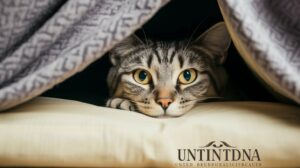Cats, like us, are individuals. Even within breeds, cats have their own personality traits and preferences. Some cats, like the Siamese, Oriental, and Bengal, are known for being especially talkative. They have a wide range of vocalizations that they use to communicate with their owners. In this article, we will explore the top 5 most vocal cat breeds and learn more about their unique vocal abilities and characteristics.
Key Takeaways:
- The top 5 most vocal cat breeds include Siamese, Oriental, Bengal, American Bobtail, and Burmese.
- Siamese cats have a distinctive and melodic voice and enjoy engaging in conversation with their owners.
- Oriental cats have a loud and raspy voice and are highly sociable and trainable.
- Bengal cats have a variety of vocalizations and use their voice to communicate their needs and desires.
- American Bobtail cats have unique vocalizations beyond the traditional meow and are playful companions.
- Burmese cats have a softer meow and enjoy conversing with their human caretakers.
Siamese Cats
Siamese cats are renowned for being vocal and expressive. As a proud owner of Siamese cats myself, I can attest to their unique ability to communicate through a range of vocalizations. From gentle meows to loud cries, Siamese cats have a melodious voice that captures your attention and melts your heart.
Siamese cats belong to the Siamese cat breed, which originated in Thailand (formerly known as Siam). Known for their stunning blue almond-shaped eyes and sleek coat, Siamese cats are among the most recognizable and beloved cat breeds.
What sets Siamese cats apart is their talkative nature. They eagerly engage in conversation with their owners, using their vocalizations to express their thoughts, desires, and emotions. Whether it’s a soft, gentle purr or a loud, demanding call, Siamese cats have a unique ability to communicate effectively.
Siamese cats are highly intelligent and social creatures. They crave interaction and enjoy bonding with their human companions through conversation. They will happily follow you around, engaging in a lively dialogue as if trying to understand and be understood.
If you’re looking for a feline companion that loves to talk and engage in meaningful conversations, the Siamese cat breed can be an ideal choice. Their vocal nature adds a delightful charm to your home, and their intelligence and sociability make them excellent companions.
Distinctive Vocalizations
Siamese cats have a wide range of vocalizations that they use to communicate their needs and emotions. Here are some of the distinctive sounds you may hear from your Siamese companion:
- Meows: Siamese cats are known for their variety of meows, ranging from soft and gentle to loud and demanding.
- Chirps: Siamese cats may use chirping sounds to express excitement or anticipation, similar to birdsong.
- Trills: Siamese cats can produce trilling sounds, which are a combination of a purr and a meow, often used as a friendly greeting.
Their vocal range and ability to mimic human speech have even earned them the nickname “Meezer” among Siamese enthusiasts.
Training and Understanding
To fully appreciate and understand your Siamese cat’s vocalizations, it’s important to establish a strong bond and develop a mutually beneficial relationship. Siamese cats thrive on human interaction, and their talkative nature is an expression of their desire to communicate with their owners.
Training your Siamese cat can help enhance your communication and strengthen your bond. Positive reinforcement techniques, such as rewards and praise, can be highly effective in teaching them commands and understanding their vocal cues.
“Siamese cats have a unique ability to convey their emotions through vocalizations. It’s like having a constant conversation partner who understands you with just a glance.”
– Siamese Cat Lover
Remember, every Siamese cat is an individual with their own personality and preferences. Spend time getting to know your Siamese companion, and you’ll discover a world of vocalizations that will warm your heart and bring joy to your home.
Oriental Cats
Oriental cats, similar to Siamese cats, are also highly vocal. They have a loud and raspy voice that can resemble a truck rumbling by. These cats are very social and love interacting with their owners. They can be trained more easily than other breeds and enjoy expressing themselves through vocalizations.
“Oriental cats have a unique vocal range that can captivate their owners. Their loud and raspy voice is unmistakable and adds charm to their personality.”– Cat Fancy Magazine
Characteristics of Oriental Cats:
- Highly vocal with a loud and raspy voice
- Social and enjoy interacting with their owners
- Trainable and responsive to learning new tricks and commands
- Expressive through vocalizations, conveying their emotions and needs
- Active and playful, needing mental and physical stimulation
If you’re looking for a cat that will keep you entertained with their chatter, the Oriental breed is a great option. Their vocal nature adds an extra layer of communication and companionship to your household. Embrace the lively conversations and unique vocalizations of Oriental cats, and they will surely become cherished members of your family.
| Aspect | Oriental Cats | Siamese Cats |
|---|---|---|
| Vocalization | Loud and raspy voice resembling a truck rumbling by | Distinctive and melodic voice with a wide range of vocalizations |
| Physical Appearance | Slim and elegant build | Graceful and slender body |
| Coat Color | Wide variety of colors and patterns | Colorpoint pattern with light bodies and darker-colored points |
| Temperament | Social, affectionate, and intelligent | Outgoing, talkative, and fond of human companionship |
Bengal Cats
Bengal cats, known for their striking leopard-like appearance, are also quite vocal. They have a variety of vocalizations, including soft meows and loud calls. Bengal cats are playful, powerful, and affectionate, making them wonderful companions. They are attention-seeking cats that enjoy interacting with their owners and will use their vocal abilities to communicate their needs and desires.
When it comes to Bengal cats, their vocal nature is just one of the many things that make them unique. They are intelligent and curious animals, always ready for an adventure. Their beautiful, spotted coat and muscular build give them a wild appearance, reminiscent of their ancestral counterparts in the jungle. Despite their wild look, Bengal cats are domesticated and make great pets for those who appreciate an active and lively feline companion.
Bengal cats thrive on mental and physical stimulation, so it’s important to provide them with plenty of toys, scratching posts, and interactive playtime. This breed enjoys exploring their surroundings and climbing to high places, so having a cat tree or shelves for them to perch on can be beneficial.
Bengal Cats Personality Traits:
- Playful
- Active
- Affectionate
- Curious
- Vocal
Due to their strong vocal abilities, Bengal cats are known to “talk” to their owners in their own unique way. They may meow softly to get attention, purr loudly when content, or even engage in short conversations with their human companions. Their vocalizations can range from gentle chirps and trills to louder calls and growls, depending on their mood and the situation.
Vocal and attention-seeking, Bengal cats are not afraid to make their needs known. They use vocalizations to communicate with their owners and express their desires, making them a lively and engaging addition to any household.
| Bengal Cat Characteristics | |
|---|---|
| Size: | Medium to large |
| Coat: | Short, dense, and silky |
| Colors: | Various shades of brown, along with silver, snow, and charcoal variations |
| Pattern: | Spotted or marbled |
| Temperament: | Active, playful, and affectionate |
If you’re considering a Bengal cat as a pet, be prepared for their high energy levels and need for mental stimulation. Provide them with plenty of exercise, interactive toys, and opportunities for mental enrichment to ensure their well-being. With proper care and attention, Bengal cats can become loyal and loving companions that will keep you entertained with their vocal conversations and playful antics.
American Bobtail Cats
American Bobtail cats are a unique and vocal breed known for their expressive communication. These cats go beyond the traditional meow and produce a wide range of sounds, including trills, clicks, and chirps. Their vocalizations are a way for them to engage in conversation with their owners and express their emotions.
American Bobtail cats have a strong bond with their family and enjoy spending time with them. They are playful and have strong hunting instincts, which adds to their lively and talkative nature. These cats are not only great companions but also love to carry on a conversation, making them an excellent choice for those who enjoy interactive and vocal pets.

Burmese Cats
Burmese cats are a delightful addition to any household. Although they may not be as vocal as some other breeds, they still have a charming and distinctive voice. These cats use their vocalizations to communicate and make their presence known to their human caretakers.
Known for their playful nature, Burmese cats enjoy engaging in conversations with their owners. They are people-oriented and seek interaction and companionship. Their vocalizations serve as a way to express their love and affection, making them wonderful companions for those who appreciate a chatty feline friend.
Burmese cats have a unique voice characterized by a sweet and slightly raspy tone. They may not be as loud as some other talkative breeds, but their soft meows still convey their desires and needs. Their gentle voice adds a touch of elegance to their conversations, making them a pleasant choice for those who prefer a quieter but still communicative cat.
Fun Fact: Did you know that Burmese cats are often described as having a voice that sounds like a soft melodious coo?
Companionship, playfulness, and a unique vocalization style are just some of the qualities that make Burmese cats special. Whether they are gently chatting with you or silently enjoying your company, these lovable cats will surely bring joy and entertainment to your home.
Summary of the Top 5 Most Vocal Cat Breeds
In summary, the top 5 most vocal cat breeds are Siamese, Oriental, Bengal, American Bobtail, and Burmese. These breeds have different vocal characteristics, ranging from distinctive melodic voices to loud and raspy tones. They are highly sociable, intelligent, and playful cats that enjoy engaging in conversation with their owners. When choosing a cat breed, consider your preferences for vocalization and find a breed that matches your desire for a talkative feline companion.
Key Characteristics of the Top 5 Most Vocal Cat Breeds
| Cat Breed | Vocal Characteristics | Personality Traits |
|---|---|---|
| Siamese | Melodic voice, loud cries, chirps, trills | Highly intelligent, sociable, and talkative |
| Oriental | Loud and raspy voice | Very social, trainable, and expressive |
| Bengal | Variety of vocalizations, from soft meows to loud calls | Playful, powerful, and affectionate |
| American Bobtail | Trills, clicks, chirps, beyond traditional meows | Strong bond with family, playful, and conversational |
| Burmese | Soft meow, sweet and slightly raspy voice | Playful, people-oriented, and loving |
These vocal cat breeds offer a range of options for cat lovers who enjoy conversing and communicating with their feline companions. Whether you prefer the melodious tones of the Siamese, the raspy voice of the Oriental, or the variety of vocalizations from the Bengal, American Bobtail, and Burmese, there is a breed that matches your desire for conversation and companionship.
When bringing a vocal cat breed into your home, be prepared for regular conversations and interactions. Provide plenty of attention, playtime, and mental stimulation to keep your vocal companion engaged and happy. Enjoy the unique vocalizations and strengthen your bond with one of these talkative cat breeds.
Why Are Some Cats More Vocal than Others?
The reasons why some cats are more vocal than others can vary. Cats use vocalizations to communicate their needs, wants, and emotions. Certain breeds, like Siamese and Oriental, have a genetic predisposition for vocalization. Additionally, individual cats within breeds may have their own personalities and preferences for vocalization. Cats may use vocalizations to seek attention, express affection, communicate discomfort or stress, or simply engage in conversation with their owners. Understanding your cat’s vocal cues can help strengthen your bond and ensure their needs are met.
Tips for Living with Vocal Cats
Living with a vocal cat can be an enjoyable and entertaining experience, but it may also require some management. Here are some tips for living with vocal cats:
- Provide plenty of interactive toys: Engage your vocal cat in playtime to keep them mentally stimulated and channel their energy into constructive activities.
- Set up designated playtime: Establish a regular play schedule to ensure your vocal cat gets enough exercise and attention, reducing the need for excessive vocalizations.
- Create a calm environment: Cats may become vocal if they feel anxious or stressed, so create a peaceful atmosphere at home with quiet spaces and hiding spots.
- Offer mental stimulation: Provide puzzle toys or interactive feeders to keep your vocal cat entertained and mentally engaged, reducing the urge to vocalize out of boredom.
- Provide hiding places: Vocal cats may feel the need to vocalize if they don’t have a quiet, enclosed space to retreat to. Provide cozy hiding spots such as cat caves or covered beds.
- Establish a routine: Cats thrive on consistency, so stick to a regular schedule for feeding, playtime, and attention. This can help minimize excessive vocalization due to uncertainty or frustration.
- Consult with a veterinarian: If your cat’s vocalization patterns change suddenly or drastically, it’s important to rule out any medical issues. Your veterinarian can provide guidance and address any concerns.
By implementing these tips, you can create a harmonious living environment with your vocal cat and ensure that their vocalizations are managed in a positive and healthy way.
Cats and Vocalization: Normal vs. Abnormal
Understanding the difference between normal and abnormal vocalization in cats is crucial for their overall well-being. Cats use vocalizations as a means of communication, expressing their needs, wants, and emotions. While some level of vocalization is to be expected, it’s important to recognize when a cat’s vocalizations may indicate a problem.
Normal vocalization in cats encompasses a variety of sounds, such as meows, purring, chirps, trills, and even gentle growls during play. These vocalizations are a normal part of a cat’s communication repertoire, and they help to establish a connection between cats and their human caretakers. Cats may use soft meows to solicit attention or food, while purring indicates contentment and relaxation. Chirps and trills are often employed as a friendly greeting.
On the other hand, abnormal vocalization in cats may include excessive or prolonged meowing, yowling, or crying. These vocalizations may be accompanied by signs of distress or discomfort, such as restlessness, aggression, or changes in eating or elimination habits. Abnormal vocalization can be indicative of an underlying medical or behavioral issue that requires attention.
If your cat’s vocalization patterns change suddenly, persistently, or worryingly, it is important to consult with your veterinarian to rule out any medical conditions or behavioral problems. Your veterinarian can conduct a thorough examination and suggest appropriate diagnostic tests to identify the underlying cause of your cat’s abnormal vocalization.
Addressing abnormal vocalization in cats involves addressing the root cause of the issue. Medical conditions such as pain, illness, or cognitive decline may require specific treatments or medications. Behavior-related issues may necessitate behavior modification techniques, environmental enrichment, or the involvement of a professional animal behaviorist.
By recognizing the signs of abnormal vocalization early and seeking timely veterinary care, you can help ensure your cat’s well-being and enhance their quality of life.

Signs of Abnormal Vocalization in Cats:
- Excessive or prolonged meowing, yowling, or crying
- Changes in vocalization patterns
- Accompanying signs of distress or discomfort
- Restlessness or agitation
- Aggression or irritability
- Changes in eating or elimination habits
Remember, as a responsible pet owner, it’s essential to be attuned to your cat’s vocalizations and behavior. By observing and addressing any changes in your cat’s vocalization, you can ensure their health and well-being.
Conclusion
Cats are unique individuals, and their vocalization habits can vary greatly. The top 5 most vocal cat breeds – Siamese, Oriental, Bengal, American Bobtail, and Burmese – are known for their talkative nature. Understanding and appreciating their vocalizations can strengthen the bond between owners and their feline companions. Whether you prefer a highly vocal cat or a quieter option, there is a breed out there that can provide the perfect level of conversation and companionship for you.
Sources
When it comes to understanding cat vocalizations and learning more about the most vocal cat breeds, it’s always helpful to consult credible sources. Here are some reliable references for cat vocalization and vocal cat breeds:
- “Most Vocal Cat Breeds” – www.chewy.com
- “The 7 Most Vocal Cat Breeds” – www.thehappycatsite.com
- “Why Are Some Cats More Vocal than Others?” – www.animalfriends.co.uk
These sources provide valuable insights into cat vocalization patterns, breed-specific vocal traits, and reasons behind a cat’s vocal nature. By referring to these sources, you can enhance your understanding of vocal cat breeds and their unique communication styles. So, dive into these resources and discover more about the fascinating world of cat vocalizations!







